Gubernatorial Candidate Larry Sharpe Wants to Reinvent New York's Education System

Larry Sharpe on the trail (photo: @Sharpe4Gov)
Larry Sharpe has a radical plan to reshape New York’s education system. The Libertarian candidate for governor, Sharpe has been campaigning vigorously around the state, making lively and entertaining media appearances, and putting forth substantive policy proposals far different from those typically discussed in mainstream state politics by the two major political parties.
Among those is Sharpe’s education plan. A former marine and University of Maryland graduate who spent some of his youth in the Bronx, Sharpe characterizes the costs of education as unsustainable, and in dire need of reform, both in terms of policy and funding. He proposes several outside-the-box policies and engages only slightly in some of the more traditional education debates, such as over charter schools and foundation aid formulas from the state to localities. He’s thinking of much more sweeping change, detailing his platform during interviews and in a policy paper released by his campaign.
At the core of his plan is a proposal to make mandatory public education in the state end at 10th grade, upon which Sharpe says that “most of the major schoolwork has already been completed and most remaining courses are electives and, for many students, college prep.” Though for too many, he says, 11th and 12th grade have too little academic rigor and purpose, too many gym classes and study halls.
In Sharpe’s proposal, students would graduate upon passing an exam at the end of 10th grade and have a series of options in front of them. With New York spending an average of more than $20,000 per year per pupil, the highest in the nation, this would free up significant funds.
Sharpe would make grants of $20,000 available to each student over the course of several years to spend on a selection of options including prep schools, which would proliferate, he believes, under his plan, to entice that newly available money and help students become ready for higher education. In what he describes as something of a GI Bill for New York youth, Sharpe would also allow the money to be used for trade school or other training programs, or even to start a business. Students could also earn an associate’s degree, he said, then pursue a bachelor’s if college is right for them.
“When we go off to college most of the time, it is 13th grade,” Sharpe said on the Max & Murphy radio show on WBAI. “You can check out all the studies. Ask anyone who has been there, our kids are not ready for college. It takes about six years for the average kid to graduate college, we should be ashamed of that.”
Sharpe also thinks that standardized tests should be done away with prior to high school, to let students learn and teachers teach without the pressure and undue influence of the exams, and that decisions on curriculum, programs, and other facets of education policy should be left at the local level.
He envisions a loss of $4 billion in federal education grant money as a result of abandoning standardized testing and Common Core learning standards, which would allow for greater experimentation in education policy, while the $4 billion deficit would be made up for with the savings from the elimination of 11th and 12th grades, he says.
“So what did I just do? I replaced all of the federal money, plus more, and provided a surplus and allowed local school districts to get rid of unnecessary administrators,” he said. “All of that happened without one extra tax dollar.”
His plan also includes severely cutting administrative staff within the school system, characterizing them as overpaid and contributing little to the system, only drawing a large paycheck and needed only because of all the overbearing federal and state regulations that he plans to either do away with or extricate New York from.
“The average administrator makes over six figures, you can easily let some of these administrators go,” he said. “You let some of these administrators go, what can you do? Teachers will have more freedom, but not just that. Teachers will have more raises, or hire more teachers, or do things that a local district should do.”
In 2016, New York’s highest-in-the-nation spending was roughly $22,366 per pupil, about 90 percent more than the national average of $11,762, according to the US Census Bureau, though numbers vary widely among New York school districts, with rich districts spending far more per pupil. That year, total spending in New York’s public schools, via local, state, and federal money, was $61.4 billion. This year, the state increased its school spending yet again, by $912 million, up to $26.7 billion total in state funds.
The state’s funding formula, Foundation Aid, plays a part in the funding inequality: a USA Today investigation in 2016 found that the formula uses obsolete data and doesn’t reduce aid to a locality, even if migratory shifts take place. A report from the State Association of School Business Officials in 2016 found that rich districts spend about $5,800 more per pupil on average than poor districts. Sharpe has noted these issues and proposes doing away with local spending on schools, having everything go through the state in an effort to make things more equal.
There's been little discussion of K-12 or higher education during the gubernatorial campaign from frontrunners Governor Andrew Cuomo, a Democrat seeking a third term, and Republican Marc Molinaro, though Molinaro recently released a plan for reimagining services for people with developmental and physical disabilities that includes elements related to K-12 and workforce education. In their recent debate, Cuomo and Molinaro both said they believe in expanding charter schools and school choice, hot button education issues that often dominate the conversation. Sharpe says he believes in choices, as outlined above, but as he recently told Susan Arbetter on The Capitol Pressroom, he does not foresee much role for charter schools if his education plan is realized.
***
by Ben Brachfeld, Gotham Gazette
@GothamGazette
Ben Max contributed to this story.
Senate Democrats Full of Optimism About Flipping Chamber, One-Party Control of State Government
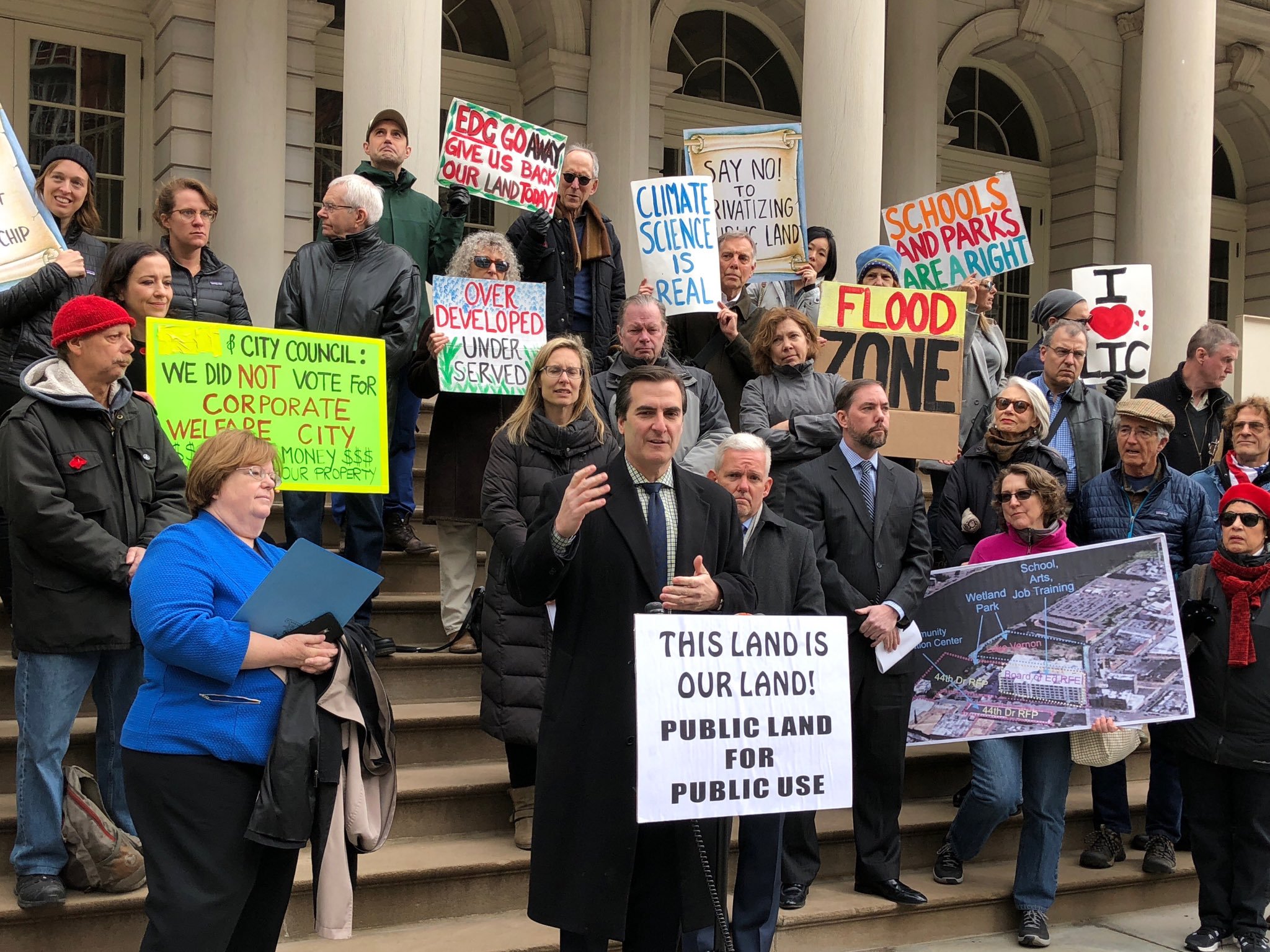
Senator Michael Gianaris (photo: @SenGianaris)
New York Democrats are confident that the upcoming elections will result in a completely blue state government, believing they will easily upend the current one-seat majority held by Republicans in the State Senate, according to the head of the Democratic Senate Campaign Committee, State Senator Michael Gianaris of Queens.
If they hold the governorship, and Democratic incumbent Governor Andrew Cuomo is expected to win a third term, and their supermajority in the Assembly, Democrats could have unfettered control of the law-making process in Albany if they are able to win a Senate majority on Election Day, November 6.
Appearing on the Max & Murphy program on WBAI radio, Gianaris recently outlined a rosy picture for Democrats, citing “about a dozen” Senate races as competitive, almost all of them for seats currently held by Republicans.
“We’re only defending one and they’re defending about 10,” Gianaris said. “We’re feeling very good about our chances in a year where Democratic turnout is reaching historic levels for an off-year.”
In the primary elections, Democratic turnout more than doubled compared to 2014, with roughly 1.5 million people casting a vote. While New York is a deeply Democratic state overall, Republicans have held to a tight Senate majority, in part by winning close races in swing districts, aided by prior drawing of legislative districts that favored their chances. But Democrats believe that registration and demographic trends, a stable of strong candidates, and broader trends including President Donald Trump’s unpopularity in New York, give them a significant edge this year.
Gianaris puts the dozen or so competitive elections into two categories — elections for seats where current Republican officeholders are retiring and elections where Republican incumbents are vulnerable. He feels the likelihood of the retirees’ seats going blue is “very, very good.” The battleground seats are largely on Long Island and in the Hudson Valley, though there are others further north and west in the state, and even one in Brooklyn.
“What’s really happening is these races have all become nationalized, and you saw the turnout spike in the primaries,” Gianaris said. “What’s happening, as we understand it, is Democrats, female Democrats in particular, are very activated by the Trump administration, by the Trump presidency, and have decided to take their country back.”
The effect of this change may first be felt in the five districts where GOP senators have retired leading up to the midterm elections.
In Syracuse, Republican John DeFrancisco is retiring, with Democrat John Mannion and Republican Robert Antonacci fighting for the seat in a district that Hillary Clinton carried in 2016. Republicans William Larkin, Tom Croci, John Bonacic, and Kathy Marchione have also announced their retirements in districts Democrats believe they have a chance of winning and have invested significantly to do so — in the fights for Larkin’s and DeFrancisco’s seats, the DSCC invested $193,000 and $270,000, respectively. This is only a small percentage of the millions of dollars Gianaris says the DSCC has put behind candidates this year, which he says is more than “any time since I’ve been in the Senate.”
Gianaris also indicated that support from Cuomo is better than it has been in cycles past, when the governor has been accused of sitting things out, tacitly approving a Republican Senate so that he can negotiate more moderate policies.
Citing six different races featuring Democratic challengers to Republicans who are not retiring, Gianaris continued his list of winnable seats, noting where the DSCC has invested resources. In Brooklyn’s District 22, Democrat Andrew Gounardes hopes to unseat Republican Senator Marty Golden, a seat Golden has held for nearly two decades but where Democrats have an enrollment advantage. Cuomo has gone to the district to campaign with Gounardes, and also cut a video ad for him.
The challenge districts Democrats think they can win extend to Putnam County’s District 40 in a race featuring Democrat Pete Harckham and Republican incumbent Terrence Murphy, and other districts, especially on Long Island, where Democrats see pick-up opportunities in the seats held by Senators Carl Marcellino and Elaine Phillips, as well as the one seat, currently held by Senator John Brooks, that Gianaris and others have acknowledged is the one they see as vulnerable. Brooks is being challenged by Republican nominee Jeff Pravato.
Gianaris sees this year as a chance for redemption for Democrats who feel robbed after seeing the Independent Democratic Conference break away from mainline Democrats and form a coalition government with Senate Republicans and Democratic Senator Simcha Felder joining the Republican conference to create an “artificial Republican majority.” The has stopped the Senate from “voting on the types of things that we should be voting on,” Gianaris said, going to list a variety of issues from women’s reproductive rights to voting reform.
Gianaris and other Democrats see New York potentially becoming a progressive leader if things go as they expect on Election Day. But Senate Republicans are doing everything in their power to sound the alarm on one-party rule in New York, arguing that the state Senate is all that stands between New Yorkers and higher taxes, government-run health care, and a state government far too oriented toward New York City at the expense of upstate and Long Island.
Gianaris dismisses those warnings. “We have an opportunity to lead the nation in standing up for progressive values and pushing back against what’s coming out of Washington,” he said.
***
by Victor Porcelli, Gotham Gazette
@GothamGazette
Molinaro Reveals Reason He Didn’t Vote for Trump
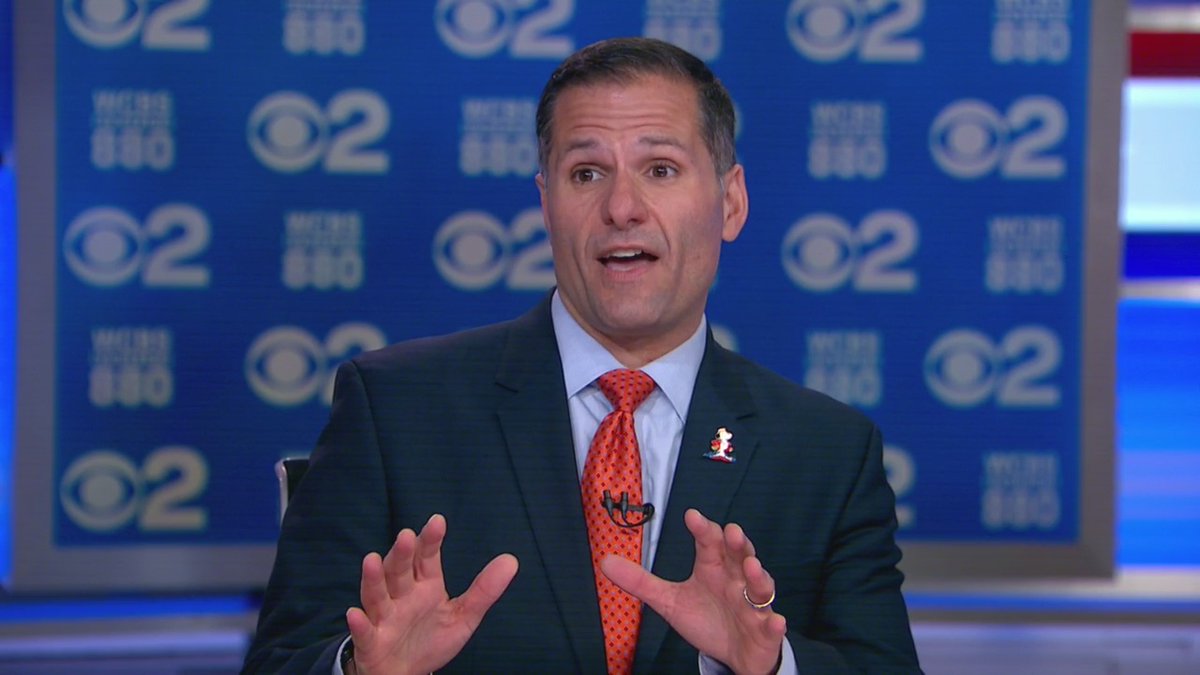
Marc Molinaro during Tuesday's debate (photo via @CBSNewYork)
Marc Molinaro, the Republican nominee for governor of New York, has long-insisted that he did not vote for Donald Trump in 2016, saying that he “had significant differences at the time” and decided to write in former Republican U.S. Rep. Chris Gibson for president.
As he’s tried to straddle the Trump divide in the New York Republican Party and appeal to independent and moderate voters in an uphill quest to unseat Democratic Governor Andrew Cuomo, Molinaro has been hesitant to explain what exactly led him to shun Trump two years ago. On Tuesday, speaking with reporters after his debate with Cuomo, during which the incumbent repeatedly tied his challenger to the president, Molinaro at last revealed more specifically what had made him unable to vote for Trump, the Republican nominee at the time and party standard-bearer.
The father of a daughter with developmental disabilities, Molinaro said that Trump mocking a disabled journalist, Serge Kovaleski of The New York Times, during a late-2015 campaign rally was the tipping point.
Like virtually all Republican candidates running this year, Molinaro is regularly asked his opinions of Trump, and he has cited several areas of disagreement, while also saying he is ready to support or challenge the president as necessary to fight for New Yorkers. Molinaro has specifically mentioned Trump’s “both sides” response to the white nationalist and response marches in Charlottesville, VA; the administration’s child separation policy at the Mexico border; and the federal tax reforms that Trump signed into law and effectively raise taxes for many New Yorkers as three areas where he has disagreed with the president.
But all of those are since Trump was inaugurated. Until Tuesday Molinaro had never explained the specifics behind his vote for Gibson, who is now retired from Congress and the chair of Molinaro’s campaign.
During the debate with Cuomo, hosted by CBS television and radio, Molinaro found himself on the defensive as the governor over and over again tied him to Trump, who has low approval ratings in New York. In one particularly stark exchange Cuomo repeatedly asked Molinaro “Do you support President Trump?” which the challenger refused to answer directly.
Molinaro attempted to get the moderators to move along, but Cuomo thundered away. Molinaro gave partial answers about calling it like he sees it and the impressive overall economy, and also repeatedly sought to turn the tables, pointing out past ties between Cuomo and Trump, who has donated more than $60,000 to Cuomo over the years and appeared in a video at Cuomo’s bachelor party (Molinaro has cozied up to the Trump family more recently, as City & State reported this week).
Curiously, Molinaro did not offer debate viewers and listeners the fact that he did not vote for Trump in 2016, perhaps indicative of the delicate balancing act he’s trying to perform in appealing to the millions of Trump voters in New York and many independents and moderates who disapprove of the president but may be willing to choose someone other than Cuomo.
When he appeared with a group of reporters covering the debate afterward, Gotham Gazette asked Molinaro why he did not offer that piece of information during the debate, as he has during a number of interviews and press conferences throughout his campaign for governor.
“I wasn’t willing to allow the governor to dictate my answer to that question,” Molinaro said, referring to when Cuomo repeatedly pressed him to explain whether he supports Trump, the governor’s own question, not one from the moderators.
“Listen,” Molinaro went on, before pausing to collect himself and continuing with his voice cracking at times, “I don’t know if the president meant it during the presidential campaign, I don’t know it, but when he acted out in a way that discredited a reporter who lived with a disability, I don’t think it was his intention, but I’ve seen it before -- in fact as a kid I probably did it myself -- and as the father of a child with a disability I wasn’t willing to put myself in the position of demeaning what my daughter goes through every day of her life.”
Molinaro then took a question about what upstate voters may have gotten from the debate.
Asked another question about Trump, and whether he sees him as a net positive or net negative for New York, Molinaro was reminded by a campaign advisor to return the focus to his race against Cuomo.
“I’m running against Andrew Cuomo,” Molinaro said. “As I have said and will repeatedly say: I want New York State to benefit from economic recovery, and to the extent that America now is the most competitive economy in the world, New York needs to benefit from that. But to allow this campaign to be about anything other than Andrew Cuomo’s failure, his incompetence, and his corruption is a disservice to the people of New York.”
[Read: Marc Molinaro and The Trump Question]
***
by Ben Max, Gotham Gazette
@tweetBenMax @GothamGazette
Max & Murphy Podcast: Cuomo-Molinaro Debate Analysis
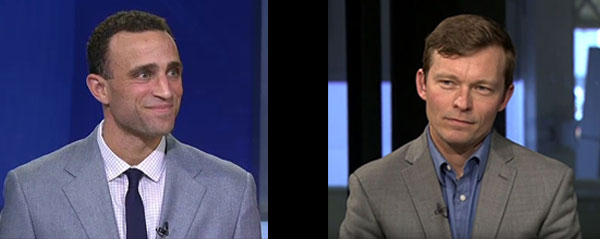
Ben Max, left, of Gotham Gazette, and Jarrett Murphy, right, of City Limits
October 23, 2018 - Max & Murphy Podcast: Cuomo-Molinaro Debate Analysis
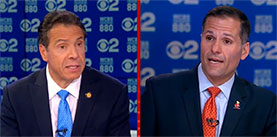 The day after the Andrew Cuomo-Marc Molinaro gubernatorial debate on CBS, hosts Jarrett Murphy and Ben Max break down what went down.
The day after the Andrew Cuomo-Marc Molinaro gubernatorial debate on CBS, hosts Jarrett Murphy and Ben Max break down what went down.
Listen to the conversation with the two candidates and let us know what you think -- we're on Twitter @TweetBenMax and @JarrettMurphy. You can listen to the show through the embedded audio below or download the episode wherever you get your podcasts, under "Max & Murphy," and listen to Max & Murphy live on Wednesdays at 5 p.m. on WBAI radio, 99.5FM or wbai.org
***
by Ben Max, Gotham Gazette
@tweetBenMax @GothamGazette
What's the [DATA] Point? 8, with David Friedfel and Patrick Orecki
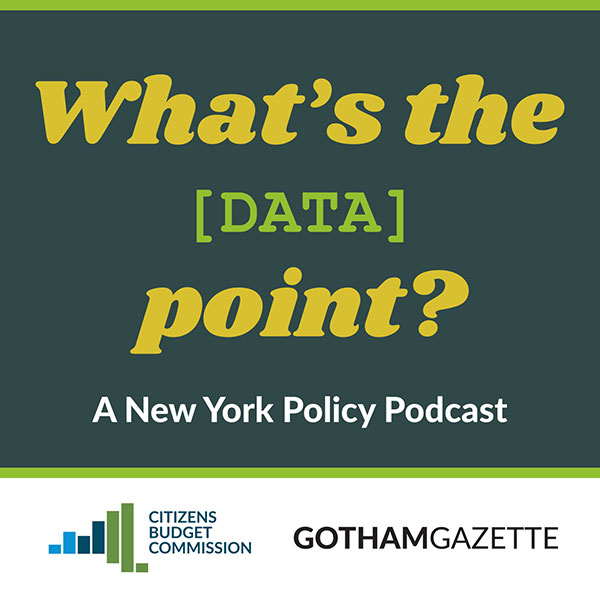
What's The [Data] Point? Episode 57 -- 8, David Friedfel and Patrick Orecki [You can download What's The [Data] Point? wherever you get your podcasts, including on iTunes]
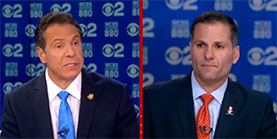 Citizens Budget Commission experts David Friedfel and Patrick Orecki joined the podcast to discuss their recent in-depth report on Governor Andrew Cuomo's two-term record and how the debate between Cuomo and Republican challenger Marc Molinaro touched (and didn't) on elements of that record.
Citizens Budget Commission experts David Friedfel and Patrick Orecki joined the podcast to discuss their recent in-depth report on Governor Andrew Cuomo's two-term record and how the debate between Cuomo and Republican challenger Marc Molinaro touched (and didn't) on elements of that record.
Listen to the conversation and let us know what you think: Ben Max of GG (@TweetBenMax), Maria Doulis of CBC (@MariaDoulis). Listen below or download wherever you get your podcasts!
***
by Ben Max, Gotham Gazette
@tweetBenMax @GothamGazette
Senate Republicans Leave Molinaro Out of Only Hope Messaging
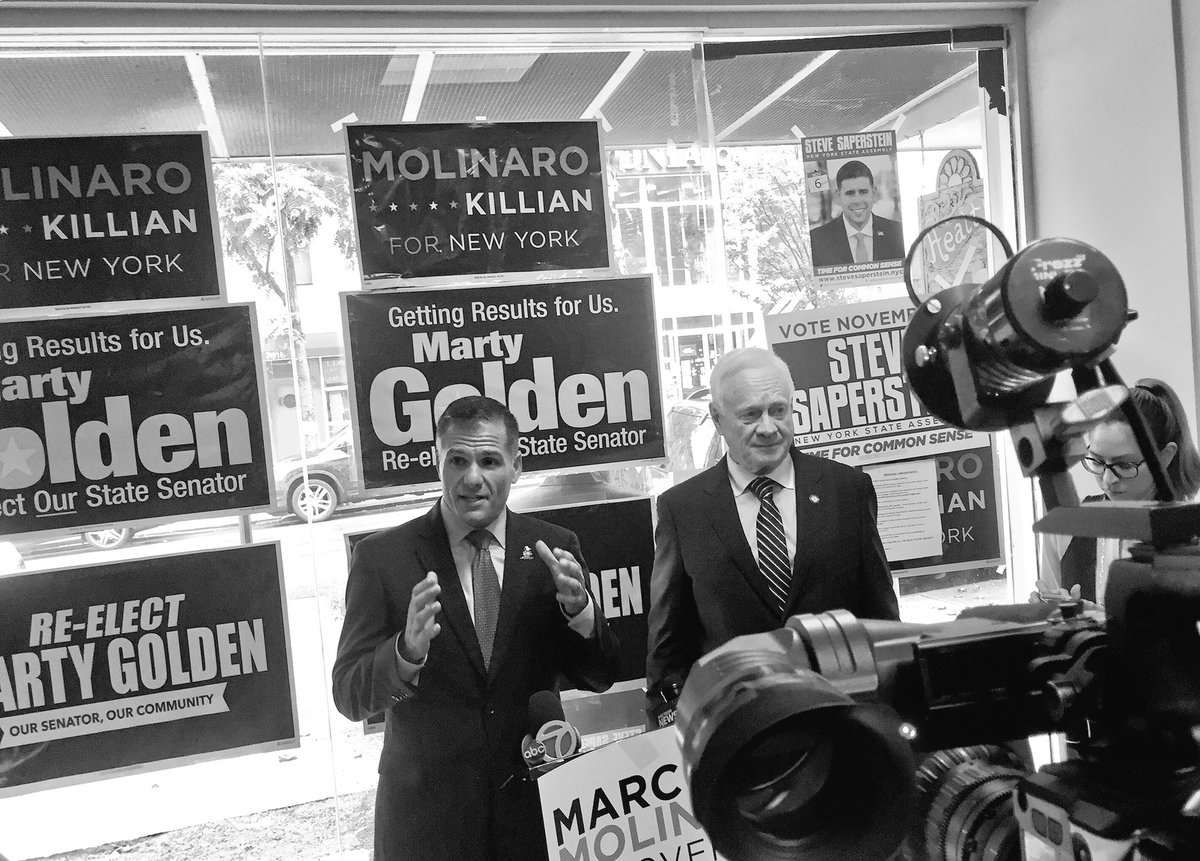
Marc Molinaro & Senator Marty Golden campaign (photo: @marcmolinaro)
Republicans fighting to keep control of the state Senate this year have been adamant that their continued majority in the chamber is the only thing standing between New York and socialism. And with the party playing defense in a number of races, there’s a certain logic to motivating voters to come out based on the idea that their district could be the one that determines who controls the entire Senate, especially resonant given the one-seat margin the Republican conference holds.
But the rhetoric around preserving the GOP majority in its lone source of statewide power seems to leave out a major issue: the party also has a gubernatorial candidate in Marc Molinaro, whose election would guarantee a divided government in Albany thanks to the Democratic supermajority in the Assembly. Molinaro may be facing long odds, but to read much GOP messaging, one could easily think the party isn’t running a candidate against Governor Andrew Cuomo at all.
In the most glaring example of this trend, Senate Majority Leader John Flanagan, of Long Island, wrote an op-ed arguing for continued GOP control of the Senate, casting the majority as “the most important firewall in history between every taxpayers’ wallet and government coffers,” and hitting common themes of higher taxes and government-run health care if Democrats are victorious. While the editorial confidently predicted “when” and not “if” Republicans control the chamber again, it makes no mention of Molinaro’s campaign for governor on the same ticket.
In a pair of stories about the governor’s involvement in close state Senate races, Scott Reif, the Republican Senate conference spokesperson, kept up the messaging that the Senate GOP was the only chance to hold back Democratic ambitions, telling the Daily News that the governor was trying to “create one-man, one-party rule” and that “there will be no accountability, no checks and balances” if Cuomo successfully helps elect a Democratic Senate majority.
"What Andrew Cuomo really wants is absolute power in Albany, and we're the only ones who can stop it," Reif told the News, again leaving out any mention of Molinaro defeating the two-term incumbent. Reif did not respond to a request for comment for this story.
Molinaro is of course facing an uphill battle in taking on Cuomo, especially in an environment seen as hostile to Republicans, and recent statewide polling saw him down 58-35 to Cuomo. Republican donors seem to believe his campaign is less of a wise investment than the state Senate, as Republican strategist Chapin Fay told the New York Times that “The funding class are investors, and they want to invest in something where they would see a return,” in a story about how the Senate GOP has greatly outraised Molinaro this year. The Business Council of New York’s PAC endorsed Cuomo over Molinaro at the same time as they endorsed only a single Democrat (of sorts) in Senator Simcha Felder, who has long-conferenced with Republicans, in an otherwise GOP set of state Senate endorsements.
Molinaro, for his part, said that he felt his campaign and the Senate Republicans were on the same page as far as messaging and working together. “Almost all of the members are helping to spread our message, we’re magnifying our resources, and working with Senator Flanagan,” Molinaro told Gotham Gazette following a Monday event in New York City. “The entire Republican conference has been good for us,” he said, favorably comparing the relationship his campaign has with the Senate GOP to the fraught one that the Rob Astorino campaign had in 2014. (Cuomo himself has been more actively campaigning for his party-mates to control the Senate, and Democrats are exceedingly optimistic they can flip the chamber.)
Currently the Dutchess county executive, Molinaro is a former member of the Assembly who was quickly endorsed by some of his former colleagues in the lower chamber of the state Legislature when he entered the race. Molinaro’s entrance fairly quickly led then-frontrunner Senator John DeFrancisco to drop out as Republican leaders from around the state coalesced behind Molinaro. DeFrancisco had been endorsed by Flanagan and several other senators before leaving the race, frustrated and headed toward retirement. Molinaro and Flanagan have not campaigned together.
But Molinaro, or his lieutenant gubernatorial running mate Julie Killian, have made campaign stops with a number of Republican state Senate candidates, like the Hudson Valley’s Annie Rabbitt, Long Island’s Jeff Pravato and Brooklyn’s Marty Golden, all of whom are in tight races for seats that could control the balance of the body.
Molinaro also brought his anti-corruption message to Syracuse in September for an appearance with Republican Bon Antonacci, who’s running to succeed DeFrancisco. Rabbit is a candidate who said she was “absolutely” motivated to run by the prospect of a Democratic Senate, and Antonacci has said a Democratic state Senate means tax hikes and increased state spending, a scenario that’s only possible if there’s a Democratic governor around to agree to them.
Molinaro, while admitting that “any one of us could lose,” also said he wasn’t bothered by the theoretical erasure of his candidacy by state Senate candidates, because there are other balances in the state Legislature to think about beyond the party balance. “I look forward to working with whomever, but I think the balance between the Senate and Assembly is important. The Senate Republican conference tends to focus its attention on upstate and Long Island, so this regional balance that’s created there, I think there’s an important benefit to that,” he said.
***
by Dave Colon, Gotham Gazette
@DavecoIon @GothamGazette
Samar Khurshid and Ben Max contributed to this article.
Cuomo Takes Aggressive Approach to Molinaro in Debate with Limited Substance
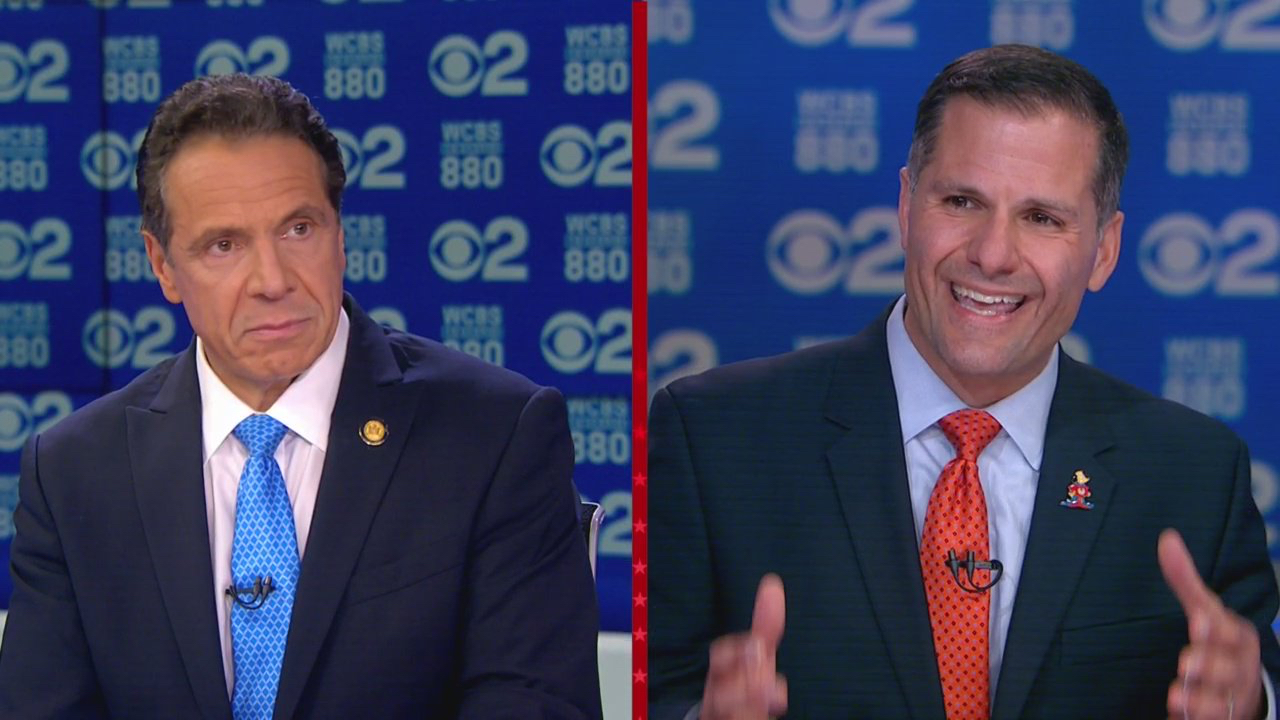
Andrew Cuomo, left, and Marc Molinaro
Governor Andrew Cuomo has said that debates can be a “disservice to democracy” and on Tuesday he ensured that what is likely to be his only general election debate provided limited clear and substantive discussion for voters to chew on ahead of the November 6 election.
A Democrat seeking a third term as governor, Cuomo took an aggressive and at times hostile approach to his debate with Republican nominee Marc Molinaro, currently the Dutchess county executive, filmed Tuesday afternoon at CBS studios in Manhattan and aired that evening on CBS TV and radio. Known for brashness and bullying, Cuomo repeatedly raised his voice, interrupted his opponent and the two moderators -- CBS’s Marcia Kramer and Rich Lamb -- and, as he does with state government, bent the shape of the debate to his liking.
Cuomo dodged several questions and insisted on having Molinaro answer some of the governor’s own, regularly exerting his will to dictate terms of engagement. More often than not, Molinaro and the moderators were overpowered, with all three parties showing frustration at times, Molinaro most often. However typically indelicate, Cuomo painted the picture of Molinaro that he wanted to get across to voters.
The Republican nominee did assert himself repeatedly, though, criticizing Cuomo on a number of fronts, including corruption in state government, a broken subway system, and budget spending. The two candidates accused each other of lying and corruption, and disagreed on several policy areas when those positions were intermittently discernable amid the noise.
While the degree to which Cuomo went on the offensive and played by his own rules may have been slightly surprising and off-putting to some, as expected, the governor repeatedly tied Molinaro to President Donald Trump, who is deeply unpopular in New York. He called Molinaro an “extreme conservative,” invoking both Trump’s policies and Molinaro’s own voting record as a county and state legislator, including repeated votes against marriage equality and equal pay for women.
Molinaro has said he did not vote for Trump in 2016, but has been hesitant to explicitly criticize the president, a tack he held to during the debate, perhaps recognizing that he cannot afford to alienate the many Trump-supporting members of the New York Republican base and party leadership. Though he has mentioned it several times during interviews on the campaign trail, Molinaro did not offer to the debate audience that he did not vote for Trump in 2016, instead praising current economic conditions and asserting that he will criticize or support the president as warranted based on the interests of New Yorkers. He distanced himself from part of Trump’s tax reforms and the president’s child separation policy at the southern border, but appeared eager to talk about anything other than Trump, though he did argue that Cuomo had closer ties to Trump, mentioning, among other things, campaign contributions Trump has given to Cuomo in the past.
In perhaps the most memorable exchange of the debate, Cuomo repeatedly asked Molinaro if the Republican nominee supports Trump, which Molinaro would not answer directly, initially asking the moderators to move the discussion along as Cuomo hammered away after having turned a discussion about health care policy into a Trump test.
Cuomo: “Are you saying you don’t support Donald Trump?”
Molinaro: “I’m saying that I’m absolutely committed to the delivery of mental health services.”
C: “Do you support Donald Trump?”
M: “Let’s get out of this conversation.”
C: “Do you support Donald Trump?”
M: “I support anyone who’s going to effectively make an investment --”
C: “Do you support Donald Trump?”
M: [silence]
C: “Do you support Donald Trump? You can’t answer it.”
M: “Today under this president and this federal government, America has the most competitive economy in the world, and New York State lags behind.”
C: “Then say it: ‘I support Donald Trump.’ Just tell the truth.”
M: [starts talking]
C: “Just say ‘I support Donald Trump.’”
M: [starts talking]
C: “You won’t say you support the president. Amazing.”
Molinaro’s frustration was evident, indicative of the broader challenge he’s facing running for governor of New York with Trump atop the Republican Party. However strong or distasteful Cuomo may have come across to individual viewers, the Molinaro campaign response to the debate was itself telling in terms of the governor’s command. The challenger and his aides focused on Cuomo’s ‘anger’ and ‘bullying,’ not any message Molinaro thought he was able to get across. Both sides appeared to see much of the same thing in the debate, with different interpretations.
On the flip side, the GOP nominee had perhaps his most clear and resonant criticism of Cuomo on corruption -- several members of Cuomo’s inner circle, including top governmental aides and campaign donors, have recently been convicted of criminal abuse of government involving the governor’s signature economic development programs.
“Governor, you have led the most corrupted state government in America. Eight individuals closely associated with your administration are now going to jail or have gone to jail for federal corruption charges,” Molinaro said. “At what point after eight years of being in office do you take responsibility? Or at least admit either you’ve benefited politically from it or you have no clue what’s going on within the administration.” He said Cuomo had allowed stealing from and defrauding taxpayers. “Anywhere else in America, no governor could possibly be running for reelection,” he said.
“You raised $101 million over eight years in exchange for $50 billion worth of state expenditures,” Molinaro added, before Cuomo gave his rebuttal.
The governor called the attacks “false and ad hominem,” but did not explain how they were false. He said at one point that, yes, members of his administration had been convicted and were being punished, but that he himself had never been accused of anything (he falsely said that federal prosecutors had said he did nothing wrong).
The governor sought to turn the tables, reiterating an attack his campaign has been using against Molinaro over a job Molinaro’s wife had gotten with a company that received Dutchess County contracts.
“For you to say in your situation, to point fingers -- yes, people in my administration made a mistake, they went to jail,” Cuomo said. “Your own county legislature is calling for an investigation on you for kickbacks and perjury, where you give a contract to a vendor and then a family member got a job and then they got another contract. That’s your own county legislature asking for an investigation of you, so I wouldn’t point fingers.”
Molinaro criticized Cuomo for shutting down the Moreland Commission to Investigate Public Corruption and pledged to launch his own if elected, saying he would appoint to it noted Cuomo critics Zephyr Teachout and Preet Bharara.
“You can’t possibly expect the voters of the state of New York to believe that you had no idea,” Molinaro said to the governor. “The exchange of state-funded, taxpayer resources for campaign contributions.”
“You know why the people would believe it,” Cuomo shot back, “because it was a two-year investigation and every U.S. attorney said I had nothing to do with anything, I did absolutely nothing wrong.”
“That’s not what they said,” Molinaro pointed out, before Cuomo went back to attacking Molinaro for a “kickback” he said is “a crime.”
During a telling moment, Lamb asked whether political discourse needs to be elevated, prompting a high-minded, bipartisan response from Molinaro about the good that can be done when people work together. Cuomo followed up by saying to his opponent, essentially, that's nice, you're terrible.
Throughout the debate Cuomo sought to portray Molinaro as “anti-woman,” referencing his voting record and the potential for the Supreme Court to overturn Roe v. Wade, which Molinaro called “settled” in saying he would uphold New Yorkers’ rights. He attempted to turn the tables on Cuomo by mentioning issues the governor’s administration has had with addressing sexual harassment claims, the fact that Cuomo excluded the only female legislative leader from negotiations of new anti-harassment policies, and a lack of public hearings on the issue of sexual harassment in what Molinaro called the “cesspool” of Albany state government.
On other policy-oriented matters, Cuomo and Molinaro did find moments of agreement: both would like to see the continued expansion of charter schools and medical marijuana, and neither expressed support for a state single-payer health care system -- Molinaro dismissed it as too much government requiring even higher taxes, while Cuomo avoided the question but said during his primary election debate with Cynthia Nixon that he’d favor such a program on the federal level, but does not think New York can afford to institute it. Molinaro indicated he wants to see a lot more local control over education. Asked about convincing Mayor Bill de Blasio to help provide space for charter schools, Cuomo joked that he and the mayor he regularly feuds with would figure it out over wine and pasta.
Molinaro reiterated his campaign pledge to significantly lower taxes -- he claims he can lower property taxes by “30 percent over five years” -- one of the major planks of his campaign, while Cuomo indicated he feels comfortable with his fiscal record, though he wants to find ways to trim spending and taxes. The governor falsely asserted that he has kept state spending to 2 percent annual increases, with Molinaro rightly pointing out that the growth has been higher, as pointed out by State Comptroller Tom DiNapoli and the independent Citizens Budget Commission. Still, Cuomo rightly said that he has had a moderate fiscal record that includes some spending restraint, though there was no discussion of the state’s significant outstanding debt, limited savings, and looming budget gaps. Cuomo touted his own record when Kramer asked him right out of the gate whether he would commit to slashing state spending by roughly 5 percent and pass the savings along to taxpayers.
Cuomo indicated a more liberal position than Molinaro on bail reform, though both said they want to see improved services for individuals with mental illness who often wind up in jail or homeless shelters, or living on the streets. He also said the state is studying the possibility of supporting safe injection sites for people addicted to heroin and opioids, something Molinaro said he is against. Cuomo indicated he would like to see the state's ethics watchdog, JCOPE, become a more independent entity, perhaps with fewer commissioners appointed by legislative leaders.
Molinaro criticized Cuomo for state parole board decisions to grant parole to individuals who have killed police officers, evaluations that Cuomo has said he disagrees with, despite appointing the board’s members, and for granting conditional pardons to tens of thousands of parolees, including sex offenders, so they can vote. Cuomo argued that the sex offenders involved have limited opportunity to be in schools to vote, but Molinaro said it was still too dangerous, and Cuomo broadly defended the program as a part of reintegrating those already released from prison.
On the MTA and New York City subway system, Molinaro said Cuomo “abandoned responsibility and we’ve seen it in a total death spiral over the course of the last several years.” He said the governor must “take ownership...take leadership responsibility” and that as governor he would clean house in MTA management, and work with the labor unions involved to identify savings that could then be shared among the unions and riders. He called the MTA “the most bloated public authority in the world.”
Cuomo asserted, “You have never seen a governor take more responsibility for the MTA than I have. I declared the state of emergency,” making a point that evokes the fact that the subway system had fallen into such a state on the governor’s watch.
Cuomo, who has a close relationship with the transportation workers union, downplayed calls for significant changes to MTA labor agreements, saying there is surely waste and it needs to be addressed, but that it wouldn’t yield the $30-$40 billion that the system needs to get into a state of good repair.
There was limited discussion of issues of concern to upstate voters, such as the struggling economies of certain areas of the state, some of which have seen significant population loss. An upstate-focused debate has been scheduled for November 1 by the League of Women Voters, with Molinaro and the three 'minor party' candidates for governor -- Green Party nominee Howie Hawkins, Libertarian nominee Larry Sharpe, and Stephanie Miner of the Serve America Movement -- all agreeing to participate. Governor Cuomo has not yet indicated his plans.
***
by Ben Max, Gotham Gazette
@tweetBenMax @GothamGazette
Max & Murphy Podcast: Battle for Control of the State Senate

Ben Max, left, of Gotham Gazette, and Jarrett Murphy, right, of City Limits
October 17, 2018 - Max & Murphy Podcast: Senator Michael Gianaris and Thomas Doherty
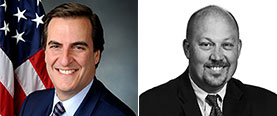
Control of the State Senate is at stake this election year in New York, with Democrats hopeful they can overcome what is now a one-seat margin that leaves them in the minority and win a majority, possibly by several seats in what many in the party hope will be a wave election. Meanwhile, Republicans hope to hold onto what is their only foothold at the state level.
Senator Michael Gianaris of Queens is the chair of the Senate Democratic Campaign Committee and joined the show to discuss Democratic efforts to flip the Senate blue and other election year dynamics, as well as the path ahead for Democrats if they do win the majority and keep their other centers of power in the Assembly and Governor's Office.
Tom Doherty is a former top aide to Republican Governor George Pataki and now a partner at Mercury, a public affairs consultancy. Doherty joined the show to give his take on the state of the Republican Party in New York and what's at stake in this year's elections.
Listen to the conversation and let us know what you think -- we're on Twitter @TweetBenMax and @JarrettMurphy. You can listen to the show through the embedded audio below or download the episode wherever you get your podcasts, under "Max & Murphy," and listen to Max & Murphy live on Wednesdays at 5 p.m. on WBAI radio, 99.5FM or wbai.org
***
by Ben Max, Gotham Gazette
@tweetBenMax @GothamGazette
'Speaker Heastie PAC' Gives to James for AG, Skoufis for Senate
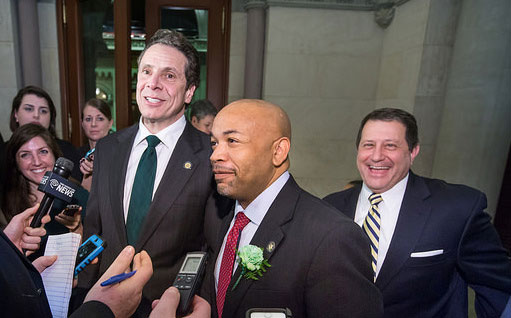
Speaker Heastie, with Gov. Cuomo and Assemblymember Morelle (Governor's Office)
New York State Assembly Speaker Carl Heastie’s eponymous political action committee has continued to donate to Democrats in competitive races this year, recently making new contributions to Public Advocate Letitia James’ attorney general campaign and Assembly Member James Skoufis’ bid for State Senate.
The latest campaign finance filings with the State Board of Elections showed that Speaker Heastie PAC spent about $26,000 between September 21 and October 2, including $10,000 each to James and to the Democratic Assembly Campaign Committee -- as speaker, Heastie is honorary chair of the DACC and he has donated $55,000 in total through his PAC, which has raised its money mostly from a variety of special interests. The PAC gave Skoufis’ campaign a $5,000 contribution -- it has sent Skoufis $12,250 overall as he seeks to move from Heastie’s conference to the upper chamber as part of the Democrats’ attempt to win control of the Senate and thus both houses of the Legislature.
Since its creation in January, Heastie’s PAC has raised $326,100 from a combination of other PACs, limited liability companies, and individuals, and has doled out just over $303,000 to several Assembly members running for reelection, candidates for State Senate, Democratic clubs in the Bronx, home to Heastie’s Assembly district and where he is intricately involved in the county Democratic Party, and to James, who is seeking to ascend from a citywide to a statewide official and become the state’s top legal officer.
James’ campaign is also being supported by much of the rest of the Democratic establishment in the state, including Governor Andrew Cuomo, while she is facing questions about her independence from figures like Heastie and Cuomo, and whether she would effectively work to root out government corruption as attorney general.
Heastie has donated a total of $31,000 to James’ campaign, which has raised more than $2.5 million and spent over $2 million so far, including during a hard-fought four-way Democrtic primary. She had about $384,000 in cash on hand as of her most recent filing, while raising more money for the home stretch before Election Day. James’ Republican opponent, Keith Wofford, is a lawyer at an international corporate firm and a first-time candidate for elected office. He has raised more than $1.6 million for his run and spent almost $1.4 million. He had about $400,000 remaining with three weeks left in the race, while also working to bring in more in order to spend it.
With Heastie assured to be reelected to another two-year term -- he is not facing a challenger -- and with Democrats overwhelmingly represented in the Assembly, his PAC has focused part of its efforts on the State Senate, where Republicans hold a one-seat majority, in an effort to regain control of the legislative chamber. Cuomo and the State Democratic Committee are spearheading that effort with a $2 million infusion of cash.
As of the last filing, Heastie’s PAC did not show any new fundraising and had about $23,000 left to dish out.
***
by Samar Khurshid, senior reporter, Gotham Gazette
@samarkhurshid @GothamGazette
The Path Forward for Cuomo's 'One Real Answer,' Congestion Pricing
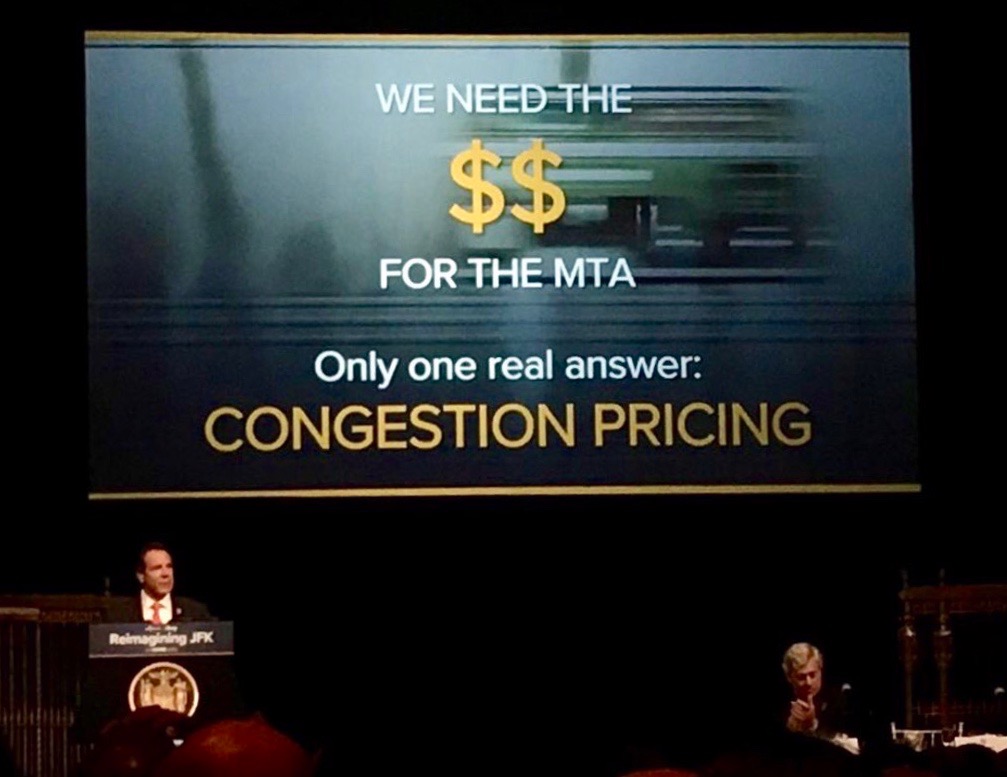
Cuomo in the midst of his ABNY presentation
One major issue that hung over the 2018 state budget season was congestion pricing, a plan to charge a fee to all motor vehicles entering parts of Manhattan and diverting the revenue toward funding the beleaguered subway system. Governor Andrew Cuomo directed a panel to study the issue, which determined that a congestion pricing scheme should be implemented and offered options for what it could look like, including a three-year, three-phase proposal. Activist groups applied significant public pressure on the governor and the Legislature. Newspaper opinion pages endorsed the idea.
But in the end, only a small part of the plan came to fruition in the budget: a surcharge on for-hire vehicles, including traditional taxis and app-based rides, entering the Manhattan business district. New charges on other cars and trucks did not come to pass. Activists excoriated Cuomo, while the governor blamed the Legislature. Cuomo said that an important first step had been passed and that he would work on additional steps in the future. That process would be led by a budget-created advisory “workgroup” made up of appointees from various stakeholders, including the governor, legislative leaders, and Mayor Bill de Blasio.
Since the March budget deal, the chorus calling for congestion pricing -- both to reduce street traffic in Manhattan and to secure a steady revenue stream to help support repair of the faltering subways -- has only grown, in number and volume.
Now, supporters of congestion pricing, from activists to City Council Speaker Corey Johnson and many others, want to ensure that it makes it into the next budget. They see a potentially more favorable environment, though a lot will be determined by the results of November’s elections, and by the pressure they put on those running.
“It's my impression that pretty much everyone running for office right now at least in the city supports congestion pricing, so I think that puts us in a position to win this year,” said Rebecca Bailin, the political director of the transit advocacy group Riders Alliance, referring to candidates for state Assembly and Senate.
Riders Alliance is a part of a new coalition, announced earlier this month, consisting of a diverse group of advocacy organizations, including those focused on the environment, immigrants, social justice, low-income communities and communities of color, and others, organized to push congestion pricing over the finish line. Between now and budget season, the groups will engage in both public demonstrations and private meetings with legislators in an attempt to steer the Legislature and governor toward implementing a full congestion pricing plan.
“We are all so reliant on our subways and buses,” Bailin said. “It is a social justice issue because it can either be a barrier or an entryway to economic opportunity, to cultural access in this city, to all the things that the city has to offer.”
The results of the recent primary elections have renewed hope that 2019 could finally be the year.
Discussion of congestion pricing and funding and fixing the MTA was a centerpiece of the Cuomo-Cynthia Nixon primary, with the governor regularly pointing to congestion pricing and the new Fast Forward plan put forth by MTA leadership to upgrade the transit system. Six of the eight members of the recently-defunct Independent Democratic Conference of the state Senate were defeated by insurgent Democrats who largely staked out more strongly supportive positions on congestion pricing than the incumbents.
Some of those defeated, like Senators Jesse Hamilton and Jose Peralta, were supporters of the scheme and were replaced by other supporters; on the other hand, cautious supporter John Liu defeated a vocal opponent, Senator Tony Avella, who is continuing his run in the general election on the Independence and Women’s Equality lines. Even Republican Senator Martin Golden of Southern Brooklyn, a perennial foe of transit and street safety activists, calls himself a supporter of congestion pricing.
"The Senate, whether controlled by the Democrats or the Republicans, is always a complicated picture,” said Alex Matthiessen, the founder of the Move NY campaign, whose comprehensive congestion pricing plan has served as a model for legislative proposals since 2015, in an email. “But the replacement of the IDC and many of its members with a crop of progressive, hungry and decidedly pro-congestion pricing senators-in-waiting portends well for this effort. But regardless of partisan control of the legislature there’s one constant: city transportation is a disaster and it’s on lawmakers to act.”
Senator Andrea Stewart-Cousins, the likely majority leader if the Democrats take the Senate, represents a suburban district and does not have a clear position on congestion pricing. A report by the Tri-State Transportation Campaign found that only 3.9 percent of Stewart-Cousins’ constituents, those driving alone into Manhattan’s proposed congestion pricing zone, would be affected by the charge. Stewart-Cousins’ office did not respond to a request for comment for this article.
In the Assembly, Speaker Carl Heastie of the Bronx is a supporter of congestion pricing, though some advocates criticized him last year for not pushing hard enough for the proposal. Heastie’s office also did not respond to a request for comment.
Senator Michael Gianaris of Queens, who served as deputy minority leader prior to the reunification of the IDC and may return to a deputy leader role in January, was once a skeptic of congestion pricing, but is now a supporter. He also supports Mayor de Blasio’s millionaires’ tax proposal, which he says can help fill the gap left between what’s funded by congestion pricing and what a comprehensive transit fix will actually cost.
“A Democratic Senate would certainly prioritize the stability and funding of the MTA, which the Republican Senate has not done,” Gianaris said in an interview. “So I think it’s a prerequisite to get to a realistic end to have a Democratic Senate. As for whether the Senate would embrace congestion pricing, beyond those of us that already do, I can’t speak for others. We’re gonna have to have those conversations. I don’t even know which senators I’m going to be looking at, because we’re hoping to pick up a lot more senators in a couple weeks.”
Cuomo, too, has only attached himself more to congestion pricing. At an event hosted by the Association for a Better New York on October 4, Cuomo said that since neither God, the city, nor the state would cough up $33 billion needed for the Fast Forward plan, “the only realistic option is congestion pricing, we have to get it done, we have to get it done next year, I need your help.”
For now, Cuomo has activists somewhat convinced.
“I am optimistic based on what he said about the need to fund the MTA,” Bailin said of Cuomo’s ABNY remarks.
Cuomo’s FixNYC panel recommended, in a January report, a broad but “phased” congestion pricing program. The for-hire vehicle surcharge, phase 2, passed, but other parts and phases of the plan did not, leaving many boosters disappointed, and some accusing Cuomo of a “bait-and-switch.”
“The Governor single-handedly revived the idea of congestion pricing and succeeded in passing the first phase of the FixNYC plan including a fee on for-hire vehicles that will go into effect next year as well as empaneling a new MTA advisory group that will provide recommendations before end of year as we develop the executive budget proposal,” Cuomo spokesperson Peter Ajemian said in a statement. “The Governor has been clear congestion pricing is the most realistic way to help fund the NYCT modernization plan and will continue leading the charge to convince legislators to pass it next year.”
The new advisory group is the MTA Sustainability Advisory Workgroup, which formally met for the first time last month and is tasked with coming up with a comprehensive plan for funding a major transit overhaul plan like Fast Forward by December 31. Though created in the enacted budget that passed in March, the panel’s members were not named until August, after Riders Alliance publicly called for the appointments. The group’s fairly tight timeline is compounded by the sheer immensity of the task before it.
But, the workgroup represents a much broader array of perspectives than FixNYC, which was an entirely Cuomo-appointed panel. The panel consists of two Cuomo appointees: CEO of the Partnership for New York City Kathryn Wylde and Metro North Commuter Council member Rhonda Herman; two appointees of congestion pricing skeptic Mayor Bill de Blasio: former City Council Speaker Melissa Mark-Viverito and Senator Gianaris; one appointee of MTA Chair Joe Lhota: Vice Chair Fernando Ferrer; two from the Senate: former City Council Member Andrew Eristoff and former DOT engineer Michael Shamma; and two from the Assembly: Assemblymembers Amy Paulin and Michael Benedetto.
“It is a group of well-meaning individuals who are trying to make recommendations to solve the MTA’s funding crisis,” Gianaris said. “And the MTA crisis in general, regardless of funding. I think efficiency is one of the other things we’re going to be looking at as well.”
Even de Blasio appears to be warming to the idea of congestion pricing, evidenced by his appointment of two supporters to the panel.
The panel has met three times so far, and Wylde, the chair, says that the meetings will occur weekly or biweekly until the end of the year, when a set of recommendations must be produced. The initial focus has been determining what the funding needs of the MTA are and how congestion pricing could form part of a solution, but the panel is empowered to go well beyond that in its recommended solutions.
“FixNYC was really focused on congestion pricing and how to implement it,” Gianaris said. “That is just one element of what this group is doing.”
Wylde elaborated on that point.
“It may be funding mechanisms, it may be reforms,” Wylde said in an interview with Gotham Gazette. “Structural and other reforms in how the MTA raises its own revenues. And then all the issues associated with congestion pricing: 1) to build support, and 2) to achieve the dual goals of new revenue generation and traffic reduction. So those have been the focus of the conversation so far.”
New York City Transit President Andy Byford’s much-talked about Fast Forward plan to modernize the subway system has been projected to cost roughly $40 billion over ten years, though Cuomo has used the $33 billion figure. Wylde said that unanimity on a true cost does not exist on the panel, and that part of the panel’s focus is in determining what it would be.
Congestion pricing remains the crux of the negotiations, and its status as a major part of the long-term transit solution appears to be agreed upon. But most analysts agree that congestion pricing would not alone cover the massive cost of fixing the transit system, and that other mechanisms are necessary as well. Estimates for annual congestion pricing revenue vary, and depend on what the program actually looks like, but have been in the $1 billion range.
The new advisory panel’s recommended solutions could, theoretically, include any of a variety of measures beyond congestion pricing -- including labor reforms, changes to the MTA’s budgeting process, an added surcharge to high-income earners’ taxes, fare hikes, or value capture -- to address long-term funding and spending issues.
“We will be careful about mission creep,” Wylde said. “The primary goal here is to identify the gap and make specific recommendations on how to deal with it, and most specifically, it’s to try and resolve an approach to congestion pricing. And so, I think that’s the focus, and to the extent that the gap exceeds the revenues that one can project from congestion pricing, looking at other sources of funding or cost reduction.”
The panel’s work will be informed by that of outside experts and advocates, and by previous plans such as FixNYC and Move NY, as well as by the expertise that the panel members themselves have from work on these issues. Political questions will come into consideration as well, especially considering the presence of three current and two former elected officials. The nature of the panel’s makeup -- that numerous stakeholders, rather than just one, appointed its members -- may allow for a broader consensus to be formed in such a way that is palatable to all parties.
“To date, I don't think party politics are playing a role,” Wylde said. “Obviously, the political sensibilities of all members of the group play into what they think is realistic and what can be accomplished. So, it's a politically sophisticated group, but not one that's just gonna be at the mercy of party politics.”
The November elections will, of course, hold significant influence over what happens in the next budget season, though Republican gubernatorial nominee Marc Molinaro, the Dutchess county executive, does support congestion pricing. However, if Republicans maintain the majority in the State Senate, they may put the brakes on the momentum toward implementation.
Advocates are, at present, optimistic about the panel and prospects despite the initial hiccups.
“It’s important there’s a panel in place that represents the interests of various government entities whose constituents are affected by our transportation crisis,” Matthiessen said. “As long as the Workgroup delivers the report by the December 31 deadline, the group’s work will be worthwhile.”
And though the December 31 deadline may seem tight for such a complex assignment, the stakeholders are confident that it will get done.
“It may be a broad topic,” Wylde said, “but it’s not a new topic.”
***
by Ben Brachfeld, Gotham Gazette
@GothamGazette




